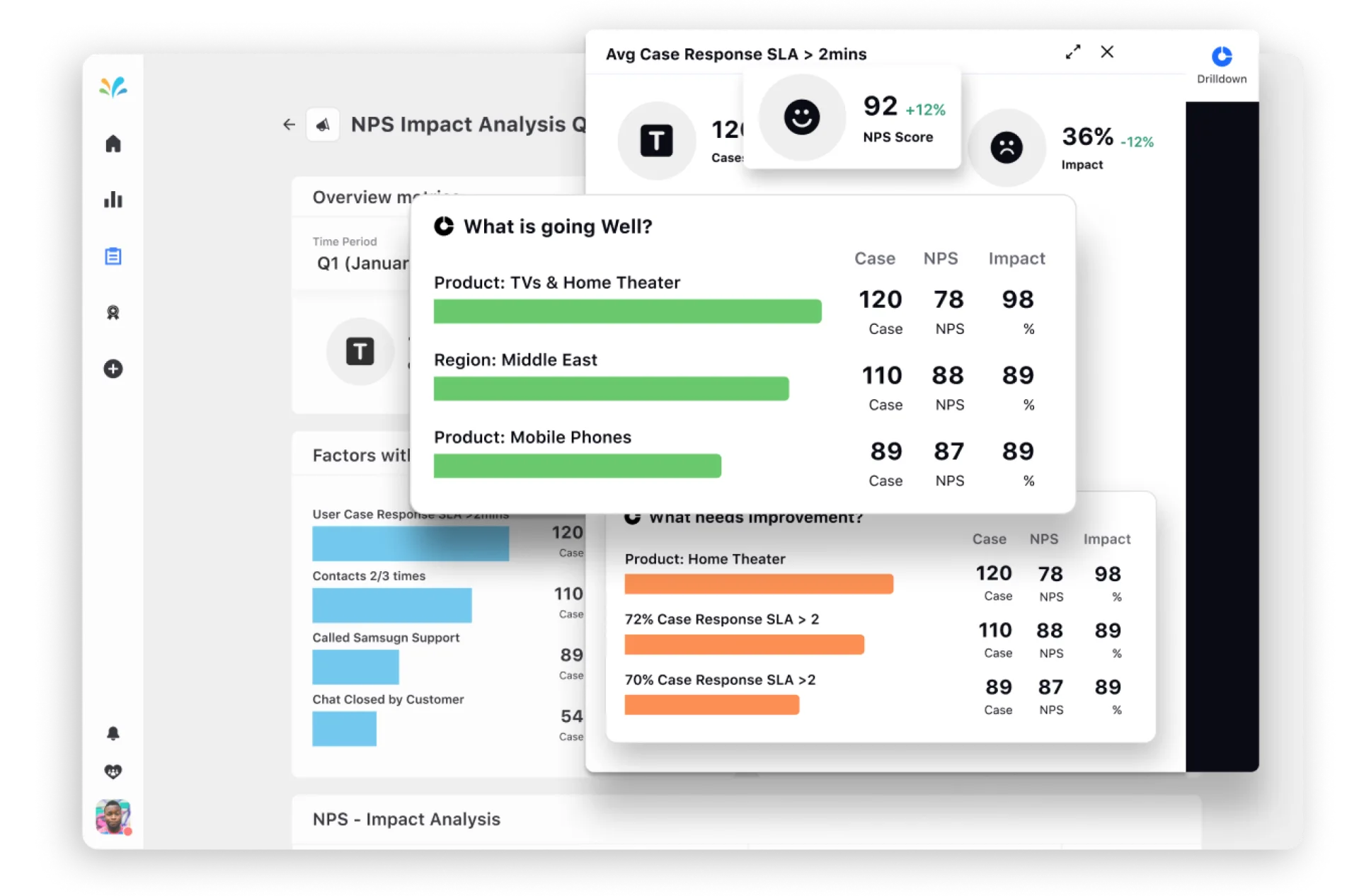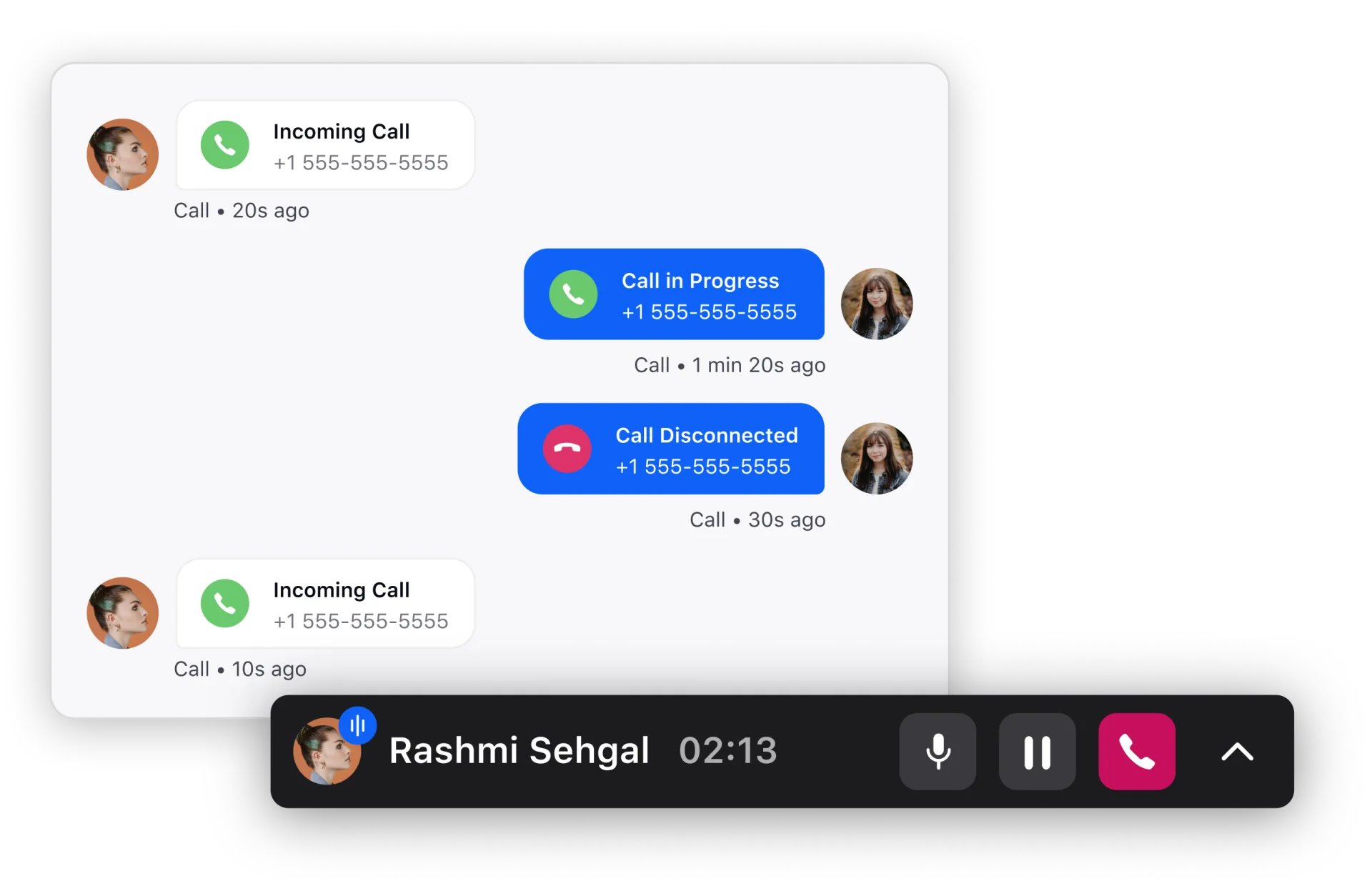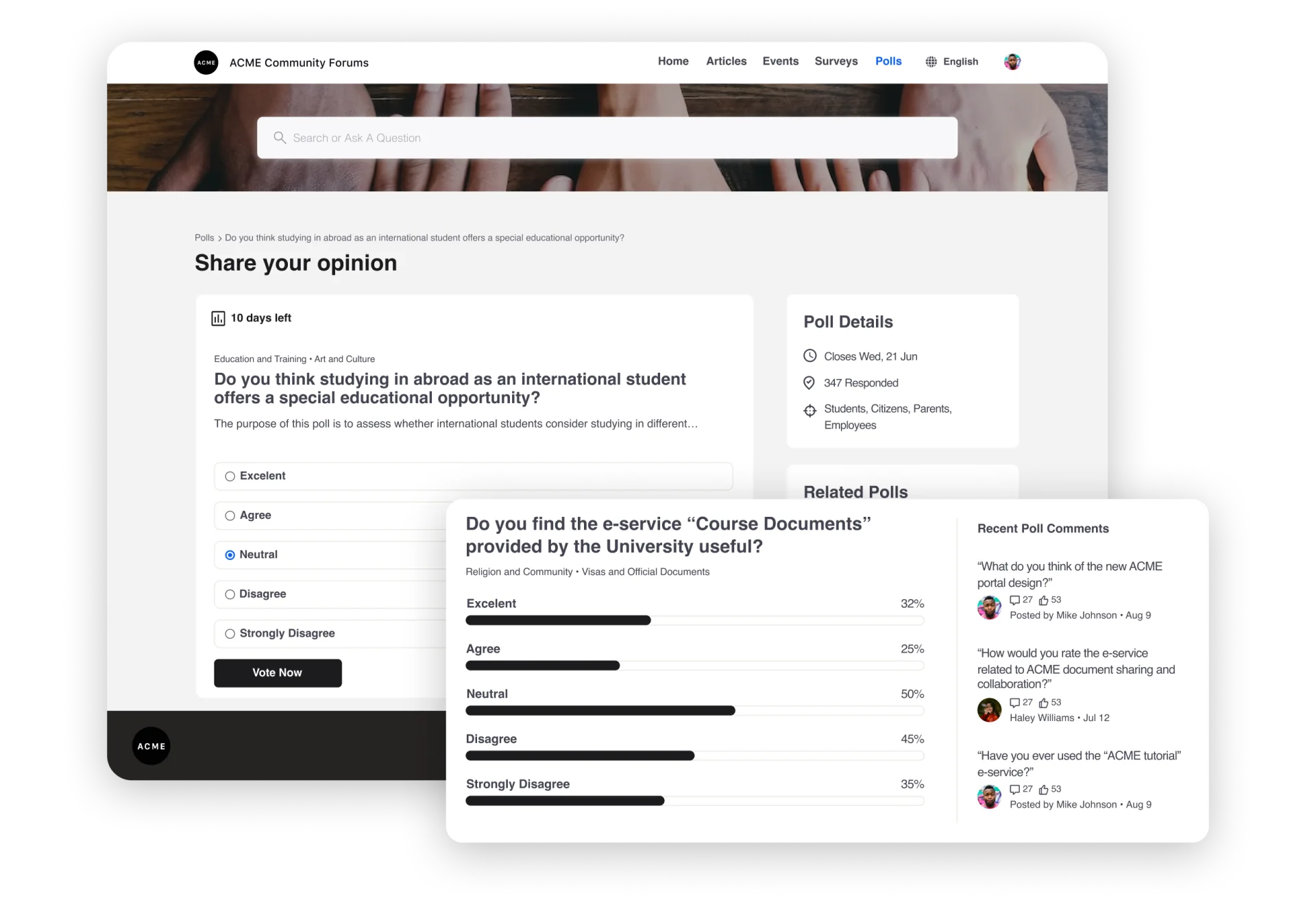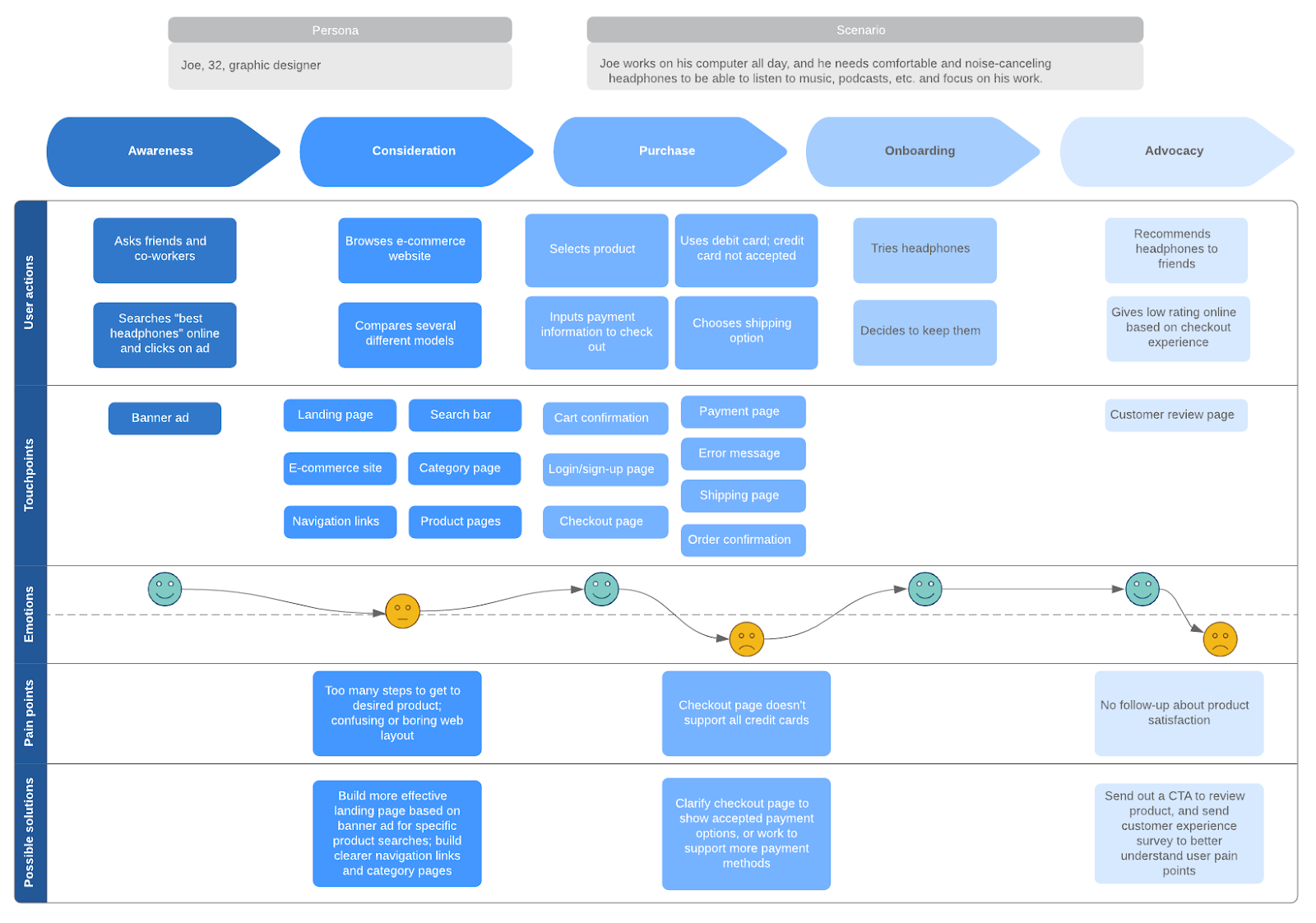- What is a customer experience map?
- Key components of a customer experience map
- Customer experience map vs. customer journey map
- Top 3 benefits of customer experience maps
- How to create a customer experience map in 8 easy steps
- Harnessing insights from your customer experience map
- Simplify customer experience mapping with Sprinklr's Unified-CXM
What is a customer experience map?
A customer experience map is a visual depiction that outlines a customer's journey, including their touchpoints and emotions with a brand. It helps the brand interpret customer behavior and optimize the customer journey.
The map tracks a customer's interaction with a brand from awareness to consideration, purchase and advocacy, giving a holistic picture of what moved the customer ahead in their journey and what held them back. With astute analysis, the customer journey map can divulge tons of actionable insights that can be used to fine-tune your product, sales, marketing, communication and support campaigns.
Customer experience mapping is an iterative process that encompasses activities like:
Research and data collection
Identification of customer touchpoints
Customer segmentation
Customer journey mapping
Emotion analysis
Gap analysis
Solution development
Implementation and testing
Feedback loop and continuous improvement
In this article, we will walk you through eight easy steps to building your first customer experience map and its key components. Let's get started.
Interesting read: Everything about customer experience management
Key components of a customer experience map
Essential building blocks of a customer experience map include:
Customer personas: Think of these as character sketches of your typical buyers. They help you know who you're serving.
Customer touchpoints: These are all the spots where customers interact with your brand, like your website, customer service or social media.
Customer journey stages: This breaks down the steps customers take, from just discovering you to becoming loyal supporters.
Emotional triggers and pain points: These are the emotional highs and lows that can make or break a customer's relationship with you.
Feedback loops: A way to continually gather customer opinions, helping you fine-tune and adapt your service or product.
Customer experience map vs. customer journey map
At first glance, customer experience maps and customer journey maps might seem the two sides of the same coin. However, they differ in many ways.
Criteria | Customer experience map | Customer journey map |
Focus | Gives a holistic view of the customer experience from start to finish. | More narrowed, often centered around a specific interaction or goal. |
Detail level | Broad strokes, capturing emotions, touchpoints and feedback. | Focus on specific steps or phases. |
Data source | Multiple channels like sales, support and social media. | Often focused on a single channel or touchpoint. |
Audience | Internal teams, stakeholders and investors. | Primarily used by specific departments—marketing or sales. |
Objective | To improve overall customer satisfaction and loyalty. | To optimize a particular stage or interaction in the customer journey. |
Learn more: How to do customer journey mapping for CX improvement
Top 3 benefits of customer experience maps
If you have ever felt like you're shooting in the dark when it comes to understanding your customers, a customer experience map is your flashlight. Let's dive into the five game-changing benefits you can reap.
1. Enhanced customer understanding
You can only serve your customers if you know them. A customer experience map is like a crystal ball, showing you not just who your customers are but also what makes them tick. From what makes them smile to what grinds their gears, you'll have insider info that lets you serve them like a pro.
2. Improved customer loyalty and retention
Imagine knowing the exact moment your customer decides to stick around. Your customer experience map highlights those golden moments, helping you replicate them. This is like discovering a goldmine of loyalty, keeping your customers around for the long haul.
3. Data-driven decision making
A customer experience map is chock-full of valuable data that guides your choices. Whether deciding on the next big feature or solving a pesky issue, you can confidently make decisions, knowing they're backed by accurate, actionable insights.

How to create a customer experience map in 8 easy steps
Here are eight essential steps to meticulously craft a customer experience map that will smoothen the navigation of the intricate landscape of customer satisfaction (CSAT).
Step 1: Define your customer personas
Knowing your customer isn't just polite; it's business-critical and crucial if you aspire for business growth. Why? Your clients commit to a long-term relationship, not just a one-time purchase. So, start by gathering data from sales records, customer interviews and surveys. Using consumer insights, create detailed personas, segmenting your customers into categories like:
Small business owners
Enterprise-level decision-makers
IT professionals
These profiles become the cornerstone of your customer experience map. They help you identify needs, preferences and pain points that can shape your product or service delivery.
💡 Pro tip: Go beyond basic demographics. Dive into psychographics like goals, challenges and frustrations to get under your customer's skin.
Step 2: Identify customer touchpoints
The moments when your customers interact with your business are called customer touchpoints, which are golden opportunities to make an impression. This could mean anything from the initial sales call to using your platform's features for your business. To get started on identifying these crucial moments:
Catalog the touchpoints: Make a list of all the places and ways your customer interacts with your business. This can be as broad as an email newsletter or as specific as an onboarding tutorial.
Rank by importance: Not all touchpoints are equal. Prioritize them based on where you can make the most impact on customer experience.

Pro tip: Don't just focus on digital touchpoints. Remember, customer relationships also involve in-person meetings or industry events. Make each interaction count, whether it's online or face-to-face.
Also Read: Your ultimate guide to building customer loyalty in 10 easy ways
Step 3: Gather pivotal customer data and feedback
Data is the lifeblood of your customer experience map. So, the next key step is arming yourself with real-world customer data and feedback via thorough market research. Both, what your customers are doing (quantitative) and how they're feeling (qualitative), matter. So, how do you catch these nuggets of wisdom?
Qualitative data: Capture the feelings and opinions of your customers through interviews, customer surveys or focus groups to understand the 'why' behind customer actions.
Quantitative data: Here, numbers do the talking. Use analytics tools to track metrics like churn rate, customer lifetime value and feature usage to zero in on the 'what' and 'how often.'
Combining these two types of data gives you a 360-degree view of the customer experience, allowing you to identify opportunities for improvement.

💡 Pro tip: Integrate real-time feedback tools into your platform. They offer immediate insights and make the customer feel heard, enhancing their overall experience.
Step 4: Plot customer journey stages
Now that you've collected invaluable customer data, it's time to create a roadmap of their interaction with your business. The customer journey is essentially a marathon with several stages that can help you fine-tune each interaction for maximum impact:
Awareness: This is when potential customers first discover you. Whether through a Google search or a referral, this is your 'first impression' stage.
Consideration: Here, prospects are weighing their options. They're looking into your features, comparing you with competitors and perhaps even trying a demo.
Decision: At this stage, your prospects become your customers. They've decided your solution is the right fit and make the purchase.
Onboarding: This is the phase where new users get familiar with your platform, using tutorials or attending webinars.
Retention: This is the long-term stage where ongoing support, feature updates and engagement campaigns keep the customer committed to your product.
Advocacy: The ultimate stage where your customers become brand advocates. Satisfied customers are now singing your praises, recommending you to others.

💡 Pro tip: This journey is often cyclical. A customer who reaches the advocacy stage can re-enter the consideration stage when upselling or renewing contracts.
Step 5: Capture emotions and pain points
When it comes to customer experience, feelings matter—a lot. Once you've outlined the journey stages, it's time to focus on customer empathy and dig deeper into the emotional landscape to get an edge. What are your customers feeling at each step? Annoyance, delight, confusion? To get actionable insights, you can:
Map emotions: Identify the predominant emotions your customers are likely to experience at each stage. These could be positive, like excitement or negative, like frustration.
Spot pain points: Use this emotional map to locate areas where customers might hit roadblocks or become disengaged. These are your opportunities for improvement.
💡 Pro tip: Always validate your assumptions with actual customer feedback. Sometimes, what you perceive as a minor inconvenience might be a significant pain point for your users.
Step 6: Highlight positive experiences and opportunities
While finding pain points and acting on them is essential, equally crucial is celebrating your successes. Recognizing and leveraging what you're doing right can amplify the customer experience. So, how can you accentuate the positive and build on it?
Spot the wins: Recognize stages or touchpoints where customers express satisfaction, delight or even surprise. It could be your intuitive UI or top-notch customer support.
Leverage strengths: Capitalize on these positive moments and replicate this experience in other aspects.
Identify growth areas: Just because something's good doesn't mean it can't be better. Spot opportunities where a 'win' can be turned into an 'exceptional win.'
Pro tip: A minor positive tweak can have a domino effect, improving multiple stages of the customer journey. Always be on the lookout for such opportunities.
Step 7: Foster cross-functional collaboration
Crafting an impeccable customer experience requires involving various teams within your organization. Here's how to ensure the amalgamation of insights and expertise from multiple departments:
Involve key players: Ensure representatives from marketing, sales, product strategy and support - all have a seat at the table.
Promote open dialogue: Encourage teams to share insights and feedback. A sales rep might have crucial data for the product team and vice versa.
Embrace a unified vision: Make sure all departments have a shared goal, maximizing customer satisfaction and streamlining the journey.
💡 Pro tip: Regular inter-departmental workshops or brainstorming sessions can keep the collaborative spirit alive and make your customer experience mapping even more effective.
Step 8: Create a visual customer experience map
Discussing and documenting the customer experience is one thing, but visualizing it brings a whole new layer of clarity. You can now get all these components to life in a format everyone can grasp and act upon:
Select your format: Whether it's a flowchart, storyboard or infographic, choose a format that best represents your customer's journey and your company's style.
Incorporate colors and icons: Use distinct colors for different journey stages and icons to depict specific touchpoints or emotions, ensuring immediate recognition.
Interactive elements: Consider adding clickable zones or hover-over tooltips in digital versions to provide deeper insights.
Iterate and refine: As you gather more data or feedback, continually refine and update your customer experience map, keeping it fresh and relevant.
💡 Pro tip: Consider creating versioned customer experience maps that allow you to track changes over time and measure their impact.
Harnessing insights from your customer experience map
Now that you've got this stellar map, what's next? It's not a one-and-done; it's a living document to guide your ongoing strategy and engagement. Here's how to use it:
Data-driven strategy: Use the map as a reference for any strategic meeting or brainstorming session. It'll keep the customer's perspective front and center.
Team alignment: Regularly review the map in team meetings to ensure everyone's focus aligns with customer needs and experiences.
Engage and update: Use the map to identify opportunities for customer engagement, such as targeted emails or tailored content, and regularly update it based on customer feedback and data.
Simplify customer experience mapping with Sprinklr's Unified-CXM
You've successfully created a visual customer experience map. But the journey doesn't end here; there's one last piece of the puzzle. While mapping the journey is vital, making it actionable, precise and efficient is paramount. This is where Sprinklr's Unified Customer Experience Management (Unified-CXM) shines.
This single-platform strategy not only connects your company’s various facets but also harnesses the power of AI for insightful research, modernized care and targeted marketing. It seamlessly integrates sales, ensuring every opportunity is capitalized upon.
Eager to optimize your customer experience mapping process? Schedule a demo today!
related products
Thank you for contacting us.
A Sprinklr representative will be in touch with you shortly.
Contact us today, and we'll create a customized proposal that addresses your unique business needs.
Request a Demo
Welcome Back,
No need to fill out any forms — you're all set.



